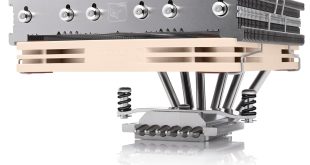To test today, we built a system from the ground up on the AsRock P55 Extreme 4 motherboard we reviewed a short while ago. This is based around an Intel Core i7 875K, which we also clocked to 4.6ghz at 1.45 volts. Special thanks as always to Intel for supplying the processors.
Room temperatures were kept at an ambient 23c which mirrors realistic temperatures for a wide range of room environments.
Comparison Coolers:
Noctua NH D14 (2 fans)
Thermaltake Frio
Test System:
CPU: Intel Core i5 875k Engineering Sample (reference and 4.6ghz/4.8ghz @ increased voltage)
Graphics Card: Sapphire HD5670 Ultimate Edition (Single and Crossfire X reviews) – passively cooled.
Motherboard: AsRock P55 Extreme 4 motherboard
Thermal Paste: Coolink Chillaramia
Chassis: Antec Dark Fleet DF 85

Memory: Kingston Hyperx 8GB DD3 1600mhz
Hard Drive: Crucial 256GB RealSSD
Monitor: Panasonic 42 inch NeoPDP 600hz Plasma
We first tested with the processor running at reference speeds and voltage.
All coolers on test today have absolutely no issue keeping our 875K engineering sample processor around 45c under load, with the Noctua NH D14 winning by 2 degrees celcius.
We now crank the clock speed to 4.6ghz and the voltage to 1.45 volts.
The Noctua NH D14 leads the pack by 5 degrees celcius and the Corator DS with a single fan is able to compete with the Thermaltake Frio with fans on high. With fans on medium the difference is 3 degrees celcius.
As we have several Coolink fans handy we decided to mount a second fan quickly to the Corator DS heatsink with some Blutak (dont laugh, it works!). We were curious to see how a second fan might help the performance, especially as the other coolers on test today are both dual fan configurations.
Adding a second fan helped to lower temperatures from 79 c to 76.5 c under load, a significant reduction and only 2.5c more than the Noctua NH D14 which is an incredible result. This shows that a dual fan configuration really does help the cooler to perform under extreme situations.
As a final test, we decided to crank the 875k to our maximum overclocked speed of 4.8ghz which requires around 1.475v for complete stability. We added another 120mm Noctua fan to the NH D14 cooler and another Coolink 120mm fan to the Corator DS, meaning each cooler was using three fans in total.
The differences were 3.5c with both coolers remaining relatively quiet. This is an incredible result for the Corator DS heatsink as we have only been able to push this 875K at 4.8ghz with the Noctua NH D14 in the past.
 KitGuru KitGuru.net – Tech News | Hardware News | Hardware Reviews | IOS | Mobile | Gaming | Graphics Cards
KitGuru KitGuru.net – Tech News | Hardware News | Hardware Reviews | IOS | Mobile | Gaming | Graphics Cards






